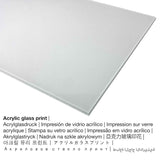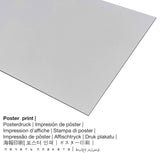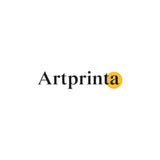Jan Abụọ, 1645 - Mpaghara Ịtali - mbipụta nka mara mma
Ụtụ gụnyere. Mbupu gbakọrọ na ndenye ọpụpụ.
Akụrụngwa ndị ahịa anyị nwere ike iburu
The product dropdown menu ofers you the opportunity to pick the material and sizeaccording to your individual preferences. We allow you to pick your favorite size and material among the following product individualization options:
- Mbipụta iko acrylic (nke nwere ezigbo mkpuchi iko): An acrylic glass print, often labelled as a plexiglass print, will change an original work of art into beautiful décor and offers a good alternative option to canvas and dibond fine art prints. Your own copy of the work of art is custom-made with the help of modern UV direct print machines. With an acrylic glass art print contrasts and also granular color details become identifiable thanks to the delicate gradation of the picture. Our plexiglass protects your selected art print against sunlight and external influences for between four and 6 decades.
- Mpempe akwụkwọ (ihe kwaaji): The Artprinta poster print is a printed sheet of canvas paper with a slight structure on the surface. Please note, that depending on the absolute size of the poster we add a white margin of around 2 - 6cm round about the artwork to facilitate the framing with your custom frame.
- Kwaaji: The canvas direct print is a printed canvas mounted on a wood frame. Furthermore, a canvas produces a attractive and comfy ambience. Your printed canvas of this artwork will allow you to transform your personal art print into a large size collection piece. How can I hang a canvas on the wall? The advantage of canvas prints is that they are relatively low in weight. This means, it is easy and straightforward to hang up your Canvas print without extra wall-mounts. That is why, a canvas print is suitable for all kinds of walls.
- Mbipụta nke aluminom: An Aluminium Dibond print is a print material with an impressive effect of depth. For our Direct Aluminium Dibond option, we print your chosen work of art right onto the aluminium composite surface. The bright and white parts of the original artwork shine with a silky gloss, however without any glare.
Nkwupụta iwu: We try our best in order to describe the art products in as much detail as possible and to exhibit them visually. At the same time, the pigments of the printed materials and the printing might differ slightly from the representation on the device's screen. Depending on your settings of your screen and the quality of the surface, not all colors are printed as exactly as the digital version depicted here. Since the fine art prints are printed and processed by hand, there might also be slight differences in the exact position and the size of the motif.
What does the curator team of the Mauritshuis say about the work of art made by Jan Both? (© - Mauritshuis - Maurithuis)
Gerrit van der Pot van Groeneveld, Rotterdam, 1785; Hendrik Muilman, Amsterdam; Lapeyrière Collection, Paris, 1817; purchased, 1817
ozi
Italian Landscape bụ ọmarịcha ihe omenkà mere Jan abụọ in 1645. A na-ese nke mbụ ya na nha elu: 51 cm obosara: 70 cm | elu: 20,1 n'obosara: 27,6 inch. Mmanụ na ọla kọpa na panel was applied by the European artist as the technique for the artpiece. Signed: J. Both is the masterpiece's inscription. It is included in the Ndị Maurithuis collection, which the Mauritshuis is home to the best artworks of Dutch painting of the seventeenth century. The nka ochie ọha ngalaba ọrụ nka na-gụnyere na n'ikike nke Maurithuis, Hague. Ebe kredit nke ọrụ nka: Gerrit van der Pot van Groeneveld, Rotterdam, 1785; Hendrik Muilman, Amsterdam; Lapeyrière Collection, Paris, 1817; purchased, 1817. Ọzọkwa, alignment bụ na odida obodo format and has a side ratio of 4 : 3, meaning that the length is 33% longer than the width. Jan Both was a male painter, whose art style was primarily Baroque. The Dutch artist lived for 34 afọ - born in the year 1618 in Utrecht, Utrecht province, Netherlands and died in 1652.
Nkọwa ọrụ nka
| Aha nke eserese ahụ: | "Okirikiri ala Italy" |
| Nhazi nke ihe nka: | sere |
| Otu sara mbara: | nka ochie |
| oge: | 17th narị afọ |
| Afọ okike: | 1645 |
| Afọ nka: | 370 afọ |
| Ọkara nke ihe osise izizi: | mmanụ na ọla kọpa na panel |
| Nha izizi (ọrụ nka): | elu: 51 cm obosara: 70 cm |
| Akara mbinye aka: | signed: J. Both |
| Ụlọ ihe ngosi nka: | Maurithuis |
| Ebe ngosi nka: | Hague, South Holland, Netherlands |
| Weebụsaịtị ihe ngosi nka: | Maurithuis |
| Ụdị ikike nka: | ngalaba ọha |
| Site n'aka: | Maurithuis, Hague |
| kreditline ọrụ nka: | Gerrit van der Pot van Groeneveld, Rotterdam, 1785; Hendrik Muilman, Amsterdam; Lapeyrière Collection, Paris, 1817; purchased, 1817 |
Ngwaahịa a
| Bipụta ngwaahịa: | ezi nka mmeputakwa |
| Usoro mmeputakwa: | dijitalụ mmeputakwa |
| Usoro mmepụta: | Mbipụta UV ozugbo (mbipụta dijitalụ) |
| Mmalite nke ngwaahịa a: | emepụtara na Germany |
| Stockdị ngwaahịa: | a na-achọ |
| Ngwaahịa were: | foto mgbidi, mgbidi gallery |
| Nhazi: | nhazi odida obodo |
| Oke akụkụ: | ogologo ruo obosara 4: 3 |
| Mmetụta nke oke akụkụ: | ogologo bụ 33% ogologo karịa obosara |
| Akwa ngwaahịa dị: | ígwè ebipụta (aluminium dibond), acrylic glass print (nwere ezigbo mkpuchi iko), mbipụta akwa akwa, mbipụta akwụkwọ mmado (akwụkwọ kwaaji) |
| Ọdịiche dị n'okirikiri akwa akwa akwa (akwa akwa): | 40x30cm - 16x12", 80x60cm - 31x24", 120x90cm - 47x35", 160x120cm - 63x47" |
| Mbipụta iko acrylic (nwere ezigbo mkpuchi iko) dị iche iche: | 40x30cm - 16x12", 80x60cm - 31x24", 120x90cm - 47x35", 160x120cm - 63x47" |
| Nhọrọ nke mbipụta akwụkwọ mmado (akwụkwọ kwaaji): | 40x30cm - 16x12", 80x60cm - 31x24", 120x90cm - 47x35" |
| Nhọrọ mbipụta aluminom: | 40x30cm - 16x12", 80x60cm - 31x24", 120x90cm - 47x35" |
| Nhazi nke nka nka: | biko buru n'uche na mmeputakwa a enweghi etiti |
Tebụl ozi omenkà
| Ihe nkiri: | Jan abụọ |
| Aha ndị ọzọ: | Monsù Bott' fiammingho, Jann Both, Boot d'Italie, Monsù Boto, Johann Both, Botts, Both Jan, Monsu Bott, John Both, Jean Both d'Italie, Jan Dirksz Both, Jan Borth, Both Jan. Holl., Booth Jan D., Bot d'Italie, Monsù Bot, Bott, Joan Both, Botta, Hoth, Bots, both jan adriaen van, Mon.ur Bot, de Bott, Both of Italy, Msù Bot, both j., Monsu Botto, J. Bott, jan booth, Giovanni Both, Gio: Bot, Jean Both dit Both d'Italie, Both, Botti, Botto, Both d'Italie, Von dem italiänischen Both, I. Both, Both d'Italie, Bootz d'Italie, J. Both d'Italie, Both J. D., Botta fiamengo, I. Boot, Jean Both d'Italie, Bot, Joh. Both, Jean Both, J. Bot, J. Bout, Jean Both dit Both d'Italie, Both i Italie, Johann Booth, John Both of Italy, Both surnommé d'Italie, Botti fiamenga, Jn. Both, Iean Bott, old Bott, Jan Bot, Both il giovine, Jan Both, J. Both, jahn both, Johan Both, Jan Bott, Jan Both of Italy, Jean Both dit Both d'Italie, Both Joh., Jean Both ou Both d'Italie, monsu` Bot, Both Jan Dircksz, both fiamingo, Bott of Italy, Jan Bogt, Monsieur Bot primo scuolaro di Claudio Lorenese, Giovanni Both detto d'Italia, J. Both dit Both d'Italie, Borth, Both of Italy, Both Jean-André, bot johannes, John Booth, jan dircksz both, Both Jan Dirksz, Jan Bodth, בות יאן |
| Gender: | nwoke |
| Obodo onye nka: | Dutch |
| Ọrụ: | onye na-ese ihe |
| Obodo obibi: | mba netherland |
| Otu nka: | nna ukwu ochie |
| Ụdị nka: | Baroque |
| Afọ ọnwụ: | 34 afọ |
| A mụrụ: | 1618 |
| Ebe omuma: | Utrecht, mpaghara Utrecht, Netherlands |
| Nwụrụ n'afọ: | 1652 |
| Ebe ọnwụ: | Utrecht, mpaghara Utrecht, Netherlands |
© nwebiisinka, Artprinta.com (Artprinta)














